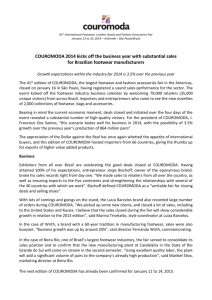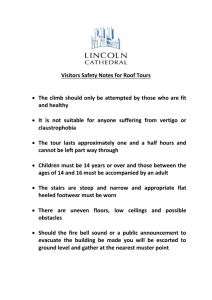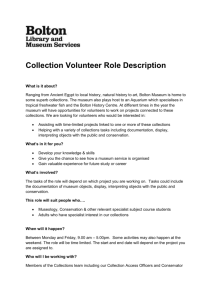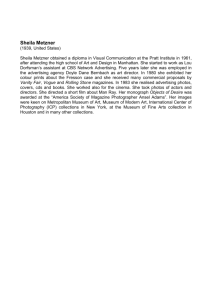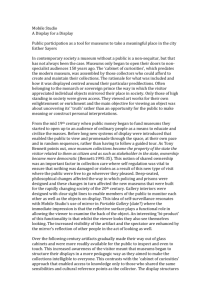Northampton Museums & Art Gallery – Designated Collections
advertisement
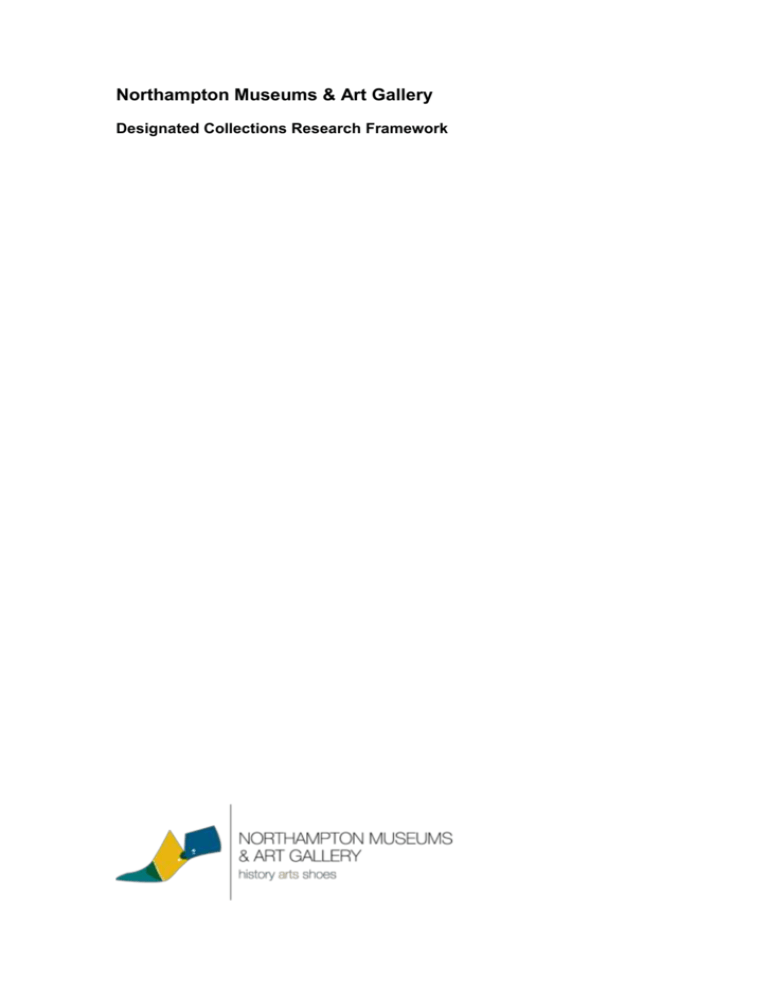
Northampton Museums & Art Gallery Designated Collections Research Framework 1 Introduction For centuries, Northampton's name has been synonymous with quality footwear, a reputation which still lives on even though shoemaking is no longer the town's largest industry. Northampton Museums and Art Gallery's Boot and Shoe Collection was founded during the Museum's early years forming the core for its present day status - as a home of comprehensive footwear and footwear related collections and expertise, and a centre for the research and study of footwear use, manufacture, creation and consumption. The UK Museums & Galleries Commission bestowed ‘Designated’ status to the collection in 1997 endorsing the museum as holder of the most significant collection of footwear and footwear related material culture in the United Kingdom. The conferring of ‘Designated’ status to the collection in relation to the UK is only a local endorsement of significance. The significance of the collections is actually international in scale, there being no other acknowledged collection anywhere else in the world that can equal the width and breadth of the collections held in Northampton. The museum service has both assisted and lead research into both the material holdings held at Northampton, and wider research related to footwear creation, consumption and cultural significance. This framework provides a structure for continuing research into the material culture held in Northampton, highlighting priority areas for research and gaps in knowledge, and pointers for wider research into the economic, social and cultural significance of footwear and footwear related material in general. Driving this specific research imperative lies an overall ambition to deliver excellence as a museum service in all aspects, with the social role of the service at the core of operating philosophy. This is reflected in the overarching ambition for how the museum wishes to be recognised: Northampton Museums & Art Gallery: An International profile with community values The shoe and shoe related collections have been at the very core of the museum service since its development in the 1860’s. They pertain to an industry that was and is at once both local and international in scope; the local collections relating to Northampton and the surrounding area are one part of international jigsaw, with footwear holding a social and cultural significance that is universal and without geographical boundaries. 2 Museum Research Policy 2.1 Northampton Museums & Art Gallery Mission The shoe heritage collections which relate both to Northampton and the rest of the world form the core business of all activity for the museum service. The imperative for the museum service is to effectively develop and promote the 2 historical and cultural significance of the collections, and extend and widen their ongoing relevance in the present. This has been summarised into the following mission statement: To create an international profile with the objects, information and collective knowledge of Northampton and its people Which is encompassed within a wider vision: To put Northampton’s unique history and heritage on the national and international stage 2.2 Northampton Museums Service Strategic Priories To deliver the overall vision and mission for the museum service there are four key strategic priorities: Resilience/Sustainability Delivering a social role Excellence – in all aspects of core museum business Profile/engagement – from a local to an international level The service is structured to ensure these priorities underpin all museum activity. 2.3 Ethical framework for Research The research that museum undertakes, facilitates, collaborates in and commissions will comply with the overall framework of the Code of Ethics of the UK Museums Association: Hold collections in trust for the benefit of society Focus on public service Encourage people to explore collections for inspiration, learning and enjoyment Consult and involve communities, users and supporters Acquire items honestly and responsibly Safeguard the long term public interest in the collections Recognise the interests of people who made, used, owned, collected or gave items in the collections Support the protection of natural and human environments Research, share and interpret information related to collections, reflecting diverse views Review performance to innovate and improve 3 3 Museum Research Strategy 3.1 Guiding principles for research The strategic priorities in of the service in relation to research are to: Generate innovative research into and around the collections and wider footwear related subject matter through building partnerships with Universities, and other institutions and individuals. Make the results of research and the knowledge and expertise of staff widely available to the public through the museum by means of publications, website, and ongoing public programme. Fully utilise and exploit the collections as a resource for developing material as well as theoretical benefits for both the academic world and wider society 3.2 General priorities for research The research that museum undertakes, facilitates, collaborates in and commissions will: 1) Create, strengthen and sustain intellectually accessible links between the museum and wider society, though presentation of the research to a wider public (via publications, website, and ongoing public programme). 2) Contribute to or draw on one or more of the following: 3) Seek to increase or refine knowledge in one or more of the following areas of enquiry: 3.3 The collections, data and archives The public programme and audience development/outreach General museological practice Typology and descriptive praxis in relation to material evidence The wider context of the footwear and footwear related collections Conceptual Framework for Footwear Research The archive and material culture held by Northampton Museums are products of a wider sphere and lifecycle that encapsulates creation, use/consumption and finally destruction. Research relating specifically to the collections is one element of wider research into footwear and footwear related material. 4 Figure 1 summarises the overall conceptual framework within which footwear research can be structured. Creation Intangible/ Immateriality Tangible/Materiality Artistic/Cultural sphere Scientific/ Technological sphere Artistic/Cultural sphere Scientific/ Technological sphere Conception theory Design theory Conception practice Design practice Creation theory Production theory Creation practice Production practice Communication and distribution theory Marketing & Retail theory Communication and distribution practice Marketing & Retail practice Use theory Consumption theory Use practice Repurposing theory Recycling theory Repurposing practice Consumption practice Recycling practice Destruction Fig. 1: Structure for Conceptualising ‘Footwear’ This can be refined and expanded out into more a more concrete framework focused on conception, creation and consumption, and related material evidence (Figure 2). Theme Detail Design/conception Footwear and footwear related material culture design/conception and formulation material evidence Individual and collective production of footwear and footwear related material culture; related wider infrastructure and background/ source material Footwear and footwear related material culture as signs/signifiers; psychology and sociology of use, consumption and meaning; individual and shared/collective culture; historical, cultural, mythological meaning Manufacture/creation Use/consumption Fig. 2: Overall framework for research – footwear and footwear related material 5 3.4 Specific areas for research Design/conception The processes involved in creating/conceiving footwear Use and reuse of design features The communication of design elements between individuals, cultures, geographical areas, and between generations Changes and morphing of creative elements Manufacture/creation Manufacturing/making process – from individual/localised concerns to global industry: Economics of manufacture Social and cultural impacts Geographical and historical differentiations Technological development Use/consumption Psychology and sociology of use and consumption Consumption and the creation of shared cultural meaning Individual and shared/collective culture Historical, cultural, ‘mythological’ meaning 6
